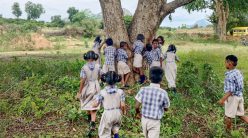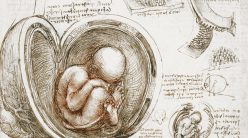Late hours on campus offer serene, vibrant vibes for students to unwind
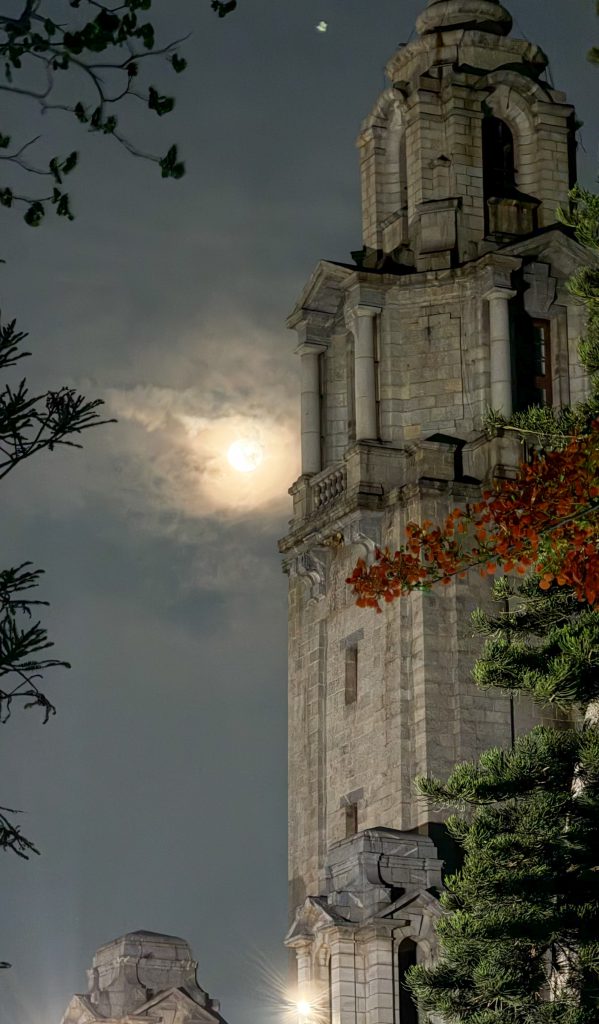
The night was filled with the sounds of crickets chirping. Leaves crunched under my feet as I walked towards the nursery gates to meet up with members of IISc’s Nature Club. We were going on a walk to see some of the nocturnal creatures on campus. Once the walk began, we switched on our torches and pointed them at the trees and ground, looking for signs of life.
Many students had joined the walk for the first time, like Surya Prakash, a Research Associate at the Centre for Neuroscience (CNS), who has always been fascinated by nature. Ekta, a UG student and member of Astrae, IISc’s Astronomy club, likes to walk around campus listening to songs and watching the stars from building terraces. “But this [night walk] is something new that I am doing,” she says.
Walking through the woods, we lifted a few large rocks and spotted some geckos running around underneath. One member noticed an insect inside a clump of dirt and called over Kedar Wagh, the convener and a PhD student under the Interdisciplinary Mathematical Sciences programme. Kedar identified it as the assassin bug – a venomous insect that kills other insects and wears their remains as a camouflage. We spotted many other fascinating insects, from colourful spiders to vibrant red bugs. Kedar, who has been exploring nocturnal wildlife for more than 13 years, and Pranav Datar, another club member and an MSc student at the Centre for Ecological Sciences (CES), often like to go around at late hours trying to spot snakes.

Soon we reached the road that leads to the back of the Department of Mathematics. Suddenly, we heard the long, shrill call of a slender loris up in the trees. It was exciting because spotting this shy animal up close is rare. All of us gathered close and started scanning the trees. When I moved my torch around, I saw a glint of light reflecting from what looked like the animal’s eyes. But before many of us could get a good look, the animal escaped. However, before the night ended, we managed to spot another pair of these elusive mammals. I felt mesmerised looking at their large eyes peeking at me from the canopy. Just as the walk approached its end, we spotted a large poisonous toad hidden in the bushes, which we carefully sidestepped. The walk ended along the Mandhara Marg, near the Main Building of IISc.
Night walks are just one of many activities that students participate in past sundown. After twilight descends, and the din of dinner plates dies down, parts of the serene campus become abuzz with activity. Nighttime offers a much-needed respite for students who slog in their labs throughout the day. Walking around the campus at night gave me a chance to see the many different ways in which students spend and cherish these late hours.
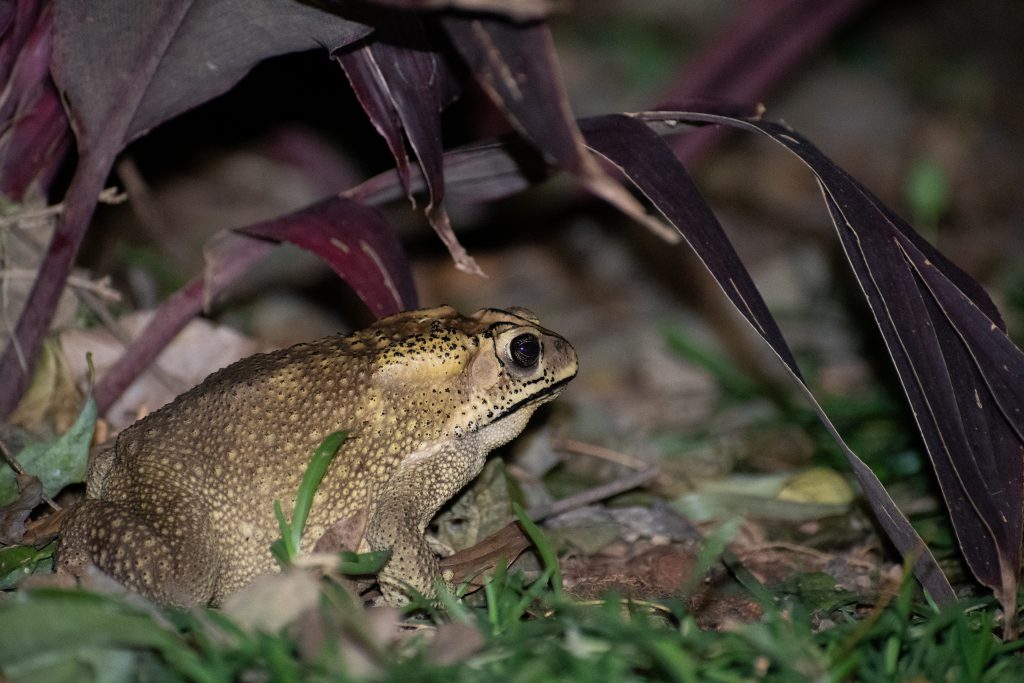
For some students, the long, nearly empty roads are perfect for walks and bike rides. “The Gulmohar Marg is simply calm and cool, and I can cycle at full speed, and still hear the call of owls,” says Abdus Shakur, a PhD student at CES. Some students, like Rahul Singh and his friends from the Department of Computer Science and Automation (CSA), like to borrow bikes from their friends and just ride around in the cool breeze. Shamsad Ali, a PhD student in the Department of Inorganic and Physical Chemistry (IPC), has named his bike ‘Dhanno’ in homage to the horse from the Bollywood classic Sholay. He likes to ride it alone on the empty roads when he can’t fall asleep.
Along Mandhara Marg, there are always some people walking, jogging and exercising. One student I met says, “There’s not a lot of people but it’s not completely empty either. It’s a good balance that I really like.”
Walking down Mandhara Marg takes one to the century-old Main Building, an iconic spot that many night owls gravitate to. Students like sitting at the base of JN Tata’s statue, to have relaxing conversations as they bask in the silent glow of lights from the building. “Every brick and archway showcases intricate charm and just sitting here looking at it makes me feel peaceful,” one student says.
Students like sitting at the base of JN Tata’s statue, to have relaxing conversations
A little behind the statue is a plain platform hidden from sight and sound. I spotted a small group of friends enjoying the isolation in silence after a long day of work. Among them, Kain Dipendrasingh, a PhD student from the Department of Aerospace Engineering, likes to write poetry. The quiet nights of IISc provide him motivation for poems of solitude and peace, he says. The group spends many nights listening to songs and walking around the campus.
In the veranda of the Main Building, Samanwita Pal, a UG first-year student, sat with a laptop and some books spread around her. “Night time is the best time to study, and I like the open space here for studying,” she says. Just in front of the JN Tata statue, three guys were drawing some lines in the sand. They were preparing for a game of Hopscotch while waiting for their friends to come and start a birthday celebration. “The birthday girl is yet to come, so we are just drawing the lines while we wait,” Aviral Sood, one of the three and a UG student, says. Like countless IISc students before them, they plan to cut the birthday cake at the stroke of midnight against the captivating backdrop of the Main Building.
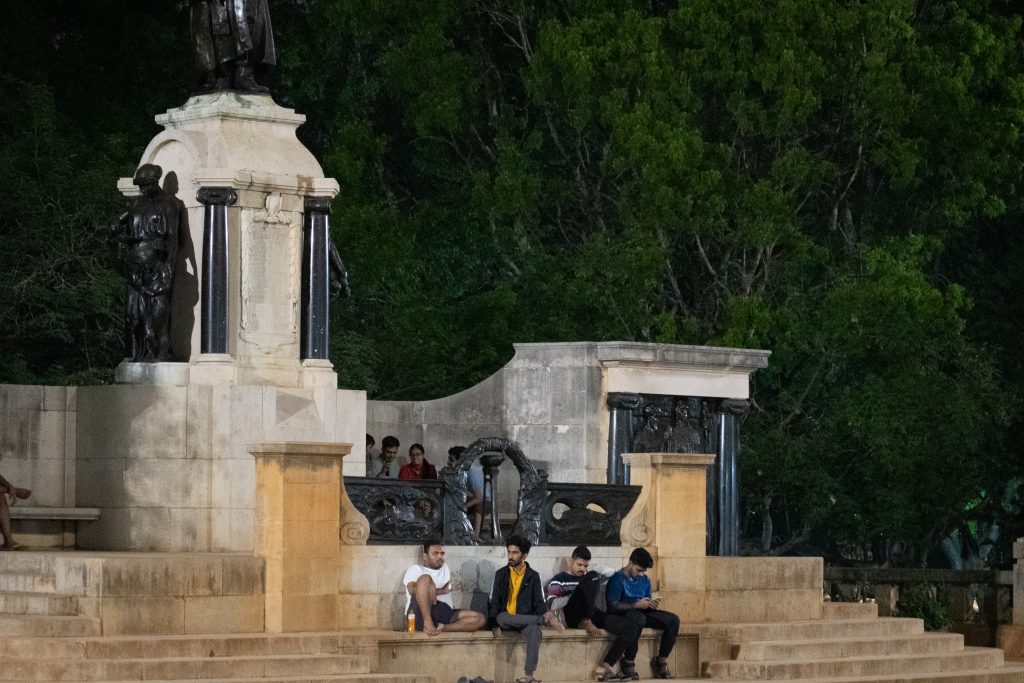
The Main Building is not the only place where festive birthday celebrations happen. As midnight approaches, the gazebos at the Sarvam complex also start filling up. Friends gather under the moonlit sky, cutting cakes adorned with candles and funny nicknames. Cake is smeared on faces, and laughter fills the air.
Even when there are no birthdays, Sarvam is often filled with people either having tea with friends or enjoying a late-night dinner. Under the water tank, someone is usually playing the guitar as their friends sing along. For students like Subhashini Murugan, from IPC, having tea with friends at Sarvam at night is the best part of campus life.
She and her friends once stayed up till the early hours of the morning, having tea and planning a weekend trip. “IISc provides a lot of social space to mingle … It provides an atmosphere where even if you do not know people, you can go and talk to them,” she says. Sougata Sarkar, a PhD student from the Astronomy and Astrophysics programme, says, “Hanging out with friends at Sarvam after a demanding workday is a complete stress buster.” Her friend Jaydeep Mandal, a PhD student from the Department of Physics, says that they hang out at Sarvam after dinner every day, eating fruits and drinking juice.
Sarvam is also a venue for various night-time activities, like music and open-mic events. One night, there was even a discussion organised on mental health. Sushmita Dutta, a PhD student from the Department of Microbiology and Cell Biology (MCB), who attended the discussion, points out how students need spaces like Sarvam to improve their mental health and unwind. “[Earlier], there was no dedicated place where you could just gather and talk at night. It was a bit depressing at that time … but now, any time you come to Sarvam you can find a lot of people sitting around, and it is much better than it used to be,” she says.
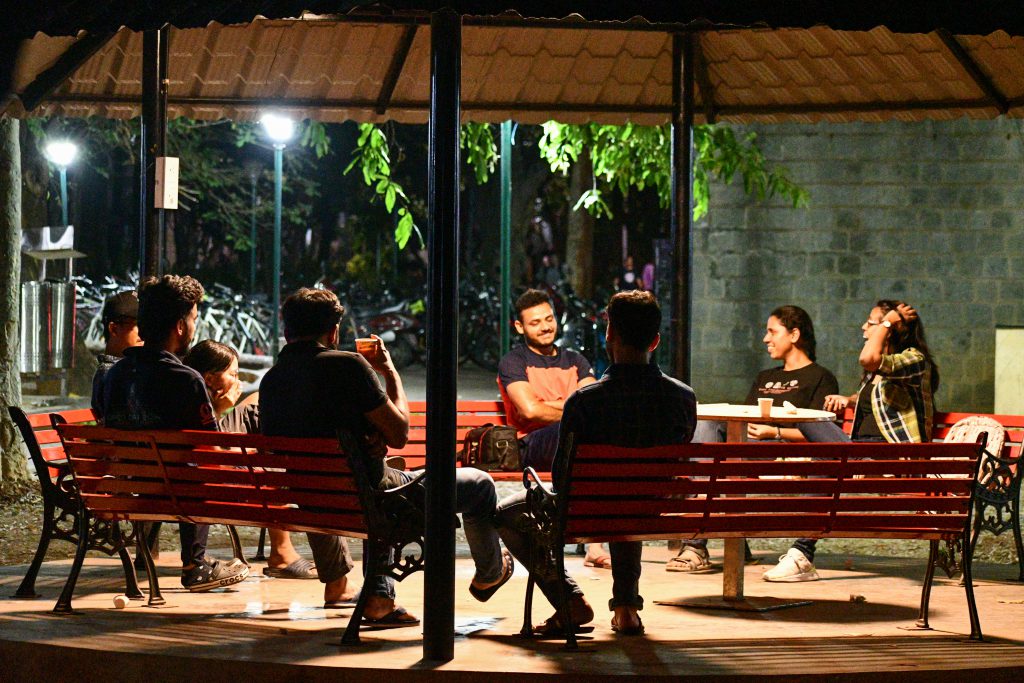
Apart from hanging out at places like Sarvam, students also spend time playing games together to relieve stress. Vinod Jiani, a PhD student at the Center for Neuroscience, likes to play cards with his friends. He is a part of a large group of friends and the only time all of them can get together is at night. “Once in a while, we play cards, mainly Bluff and Uno … Cards are a good excuse to get together and talk while having some fun. And we love Bluff,” he says. Most hostel lobbies have TT tables, foosball tables and carrom boards, and I almost always see them occupied even at night. The atmosphere is always cheerful and loud, with students hollering in excitement.
When exam season approaches, the TT tables in the New Girls Hostel lobby gain a second purpose. Students gather around them late at night, to discuss and study together, something that is difficult to do in the quiet library. “For collaborative discussions, it is best to have a common area like this,” Kevin Mahesh, an MTech student at the Department of Computational and Data Sciences, says. Even when exams are not there, students engage in impromptu study sessions and lively debates over tea, illuminated by the soft glow of laptops.
Apart from hanging out at places like Sarvam, students also spend time playing games together to relieve stress
Many students also need to stay back in labs at night – some experiments require 24-hour observations, resulting in students staying up all night in departments like CeNSE and DBG.
One of the departments that is often busy through the night is the Department of Design and Manufacturing. Students here take part in brainstorming sessions in the night that sometimes go on until the wee hours of the morning. Hemanth GN, an MDes student, explains that these sessions need to happen in groups, and everybody becomes free only during the night. “Our department is multi-disciplinary … So, from all the streams, ideas will be dumped on the table and we will see which is feasible. There are some 14-15 steps we will have to follow and then we’ll come up with a design,” he explains.
Sometimes these discussions go on till 7.30 in the morning after the sun has risen and birds have started their morning clamour. The students need to squeeze in some quick shuteye, and then rush to their classes and labs. They will have to spend another long day filled with research and studies before they can return to the leisure and freedom that the night offers.
Shreya Gangwal is a PhD student in the Centre for Ecological Sciences, IISc and a science writing intern at the Office of Communications


